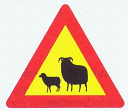Driving in Iceland
Important points
you drive on the right side of the road and overtake on the left.
The general speed limit is 30-50 km/hour in populated areas, 80 km/hour on gravel roads in rural areas and 90 km/hour on paved roads.
Drivers and all passengers are required by law to wear seatbelts.
•It should be noted that children must either wear seat belts or be in car safety seats, depending on their age and maturity.
•It is against the law to operate a vehicle in Iceland after having consumed alcohol.
•Iceland requires that vehicle headlights be on at all times, day and night when driving.
•During the summer, there’s daylight both day and night and the day seems long. Drivers must be aware of this fact and avoid driving for too long, over the summer night.
•In several places there are traffic signs (rectangular with white numbers on blue background), indicating the recommended maximum speed and where drivers
should realize that the permitted speed limit can’t be recommended because of the driving conditions.
• The use of hands-free equipment is an obligation when talking on a mobile phone and driving at the same time. However, it is recommended not to use the phone at all while driving.
• Please watch Driving with Elfis here on the SafeTravel site or on www.drive.is to get to know more about driving safely in Iceland.
• Vegagerðin (www.road.is) Iceland’s road administration site details road openings and closings around the country. Vital if you plan to explore Iceland’s little-visited
corners and remote highlands, and for information about winter road access.

Single-lane bridges
Single-lane bridges. The actual rule is that the car closer to the bridge has the right-of-way.
However, it is wise to stop and assess the situation. This sign indicates that a single-lane bridge is ahead.

Paved road changes to gravel.
Sadly, accidents do occur on rural roads where a paved road suddenly changes to gravel.The main reason is that drivers do not reduce their speed before it changes to gravel and consequently loses control of the vehicle.
This sign indicates a changeover to gravel.
Blind hills
Blind hills, where lanes are not separated, should be approached with caution.There are many blind curves in Iceland that test a driver’s skill, Slow down!
This sign indicates a blind hill.
Gravel roads
When driving on gravel roads, which are often quite narrow,It is important to show caution when approaching another car coming from the opposite direction.
inexperienced drivers can easily lose control of the car on unpaved roads, the maximum speed is 80 km/h but often that speed is too high.
The roads are narrow and it's easy to lose control of the car

Sheep on the road
In Iceland, you can expect livestock to be on or alongside the road.It’s usually sheep but sometimes horses and even cattle can be in your path.
This is common all over the country so drive with caution.
